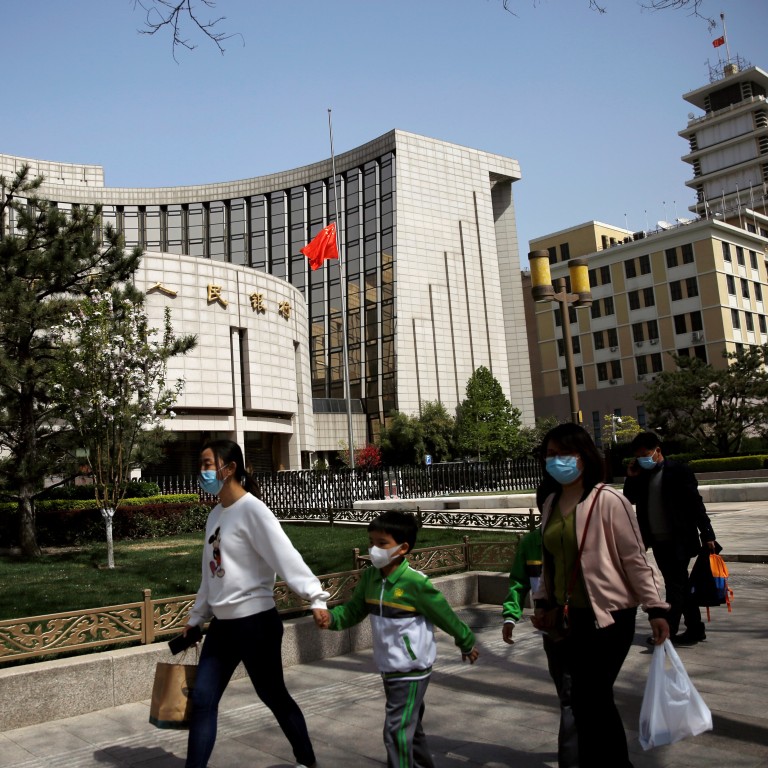
China urges markets to focus on rates, not liquidity, to avoid ‘misunderstanding’ of monetary policies
- China is poised to withdraw its 9 trillion yuan (US$1.4 trillion) stimulus rolled out last year to fight the coronavirus and help affected businesses
- The US Federal Reserve and the European Central Bank, on the other hand, are continuing to signal monetary policy loosening
China’s central bank has called for attention to be focused on policy rates rather than liquidity operations as concerns over the country’s exit from its coronavirus-driven stimulus package hang over the world’s second-largest capital market.
The People’s Bank of China (PBOC) injected only around 430 billion yuan (US$66 billion) of liquidity into the market ahead of the Lunar New Year holiday, 750 billion yuan less than a year earlier.
A large liquidity withdrawal also started on Thursday, with only 20 billion yuan of reverse repo sold despite 280 billion yuan of reverse repo and 200 billion yuan of medium-term lending (MLF) facilities maturing.
The key areas to watch should be policy rates of open market operations and the medium-term lending facility, as well as the operation of loan prime rates
“Currently, the market should not pay too much attention to the liquidity volume of the central bank. Otherwise, it could misunderstand its monetary policies,” said a commentary in the Financial News, a newspaper affiliated with China’s central bank.
“The key areas to watch should be policy rates of open market operations and the medium-term lending facility, as well as the operation of loan prime rates.”
The commentary echoed the PBOC’s fourth quarter monetary policy implementation report a week ago, which vowed to strike a balance between economic recovery and risk prevention, while staying “flexible, targeted and appropriate”.
The seven-day pledged repo rate for depository institutions in the interbank market, a key short-end parameter for the central bank, remained roughly stable at around 2.2 per cent during the holiday.
The one-year negotiable certificate of deposit also remained stable, just 10 basis points higher than the MLF rate.
China is poised to withdraw its 9 trillion yuan (US$1.4 trillion) stimulus rolled out last year to fight the pandemic and help affected businesses, in stark contrast to the US Federal Reserve and the European Central Bank who continue to signal loosening during their policy meetings.
While China’s financial regulator expressed concerns over the fast rise in macro leverage and the risk of asset bubbles, central bank governor Yi Gang assured the market last month that there would not be a policy U-turn and the tapering would not happen in the short term.
Ding Shuang, chief Greater China economist of Standard Chartered Bank, said the end of January rate spike once aroused huge concerns, but it is now under control.
Despite the strong demand for capital, market rates haven’t deviated too much from policy rates
“Despite the strong demand for capital, market rates haven’t deviated too much from policy rates,” he said.
“Monetary policy tapering is the direction. As the pandemic was well contained during the Chinese New Year holiday and the economic trends are good, the central bank could become more determined.”
China Merchants Bank estimates no abrupt change to the current monetary stance, saying the recent liquidity management is set to reduce one-way loosening expectations.
“The central bank stays on high alert to idling of funds and speculation,” according to research led by its macro analyst, Tan Zhuo. “In the medium and long run, economic recovery and inflation will be key parameters on the way of policy neutralisation.”

03:42
SCMP Explains: The ‘two sessions’ – China’s most important political meetings of the year
Many economists are also forecasting a strong start for industrial production because a large number of migrant workers did not return home for the holidays.
Chinese lawmakers will meet in Beijing at the start of March for the key annual “two sessions” parliamentary meetings, when government goals including the annual growth target, fiscal deficit ratio and government bond quota will be discussed and finalised.

